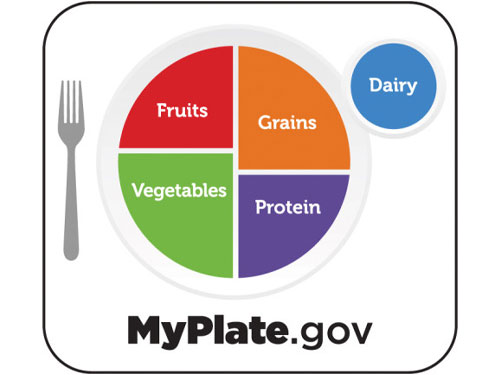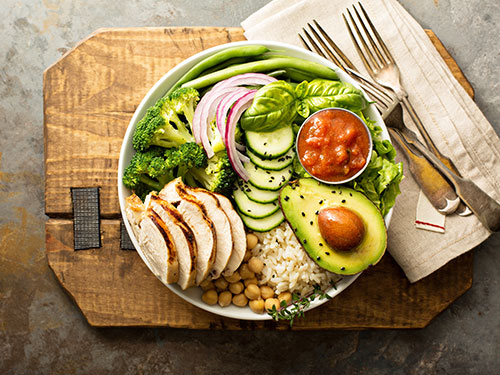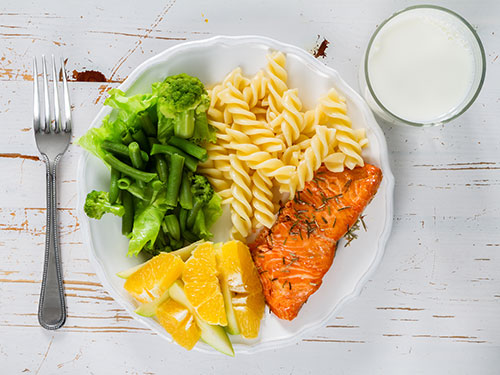
Fact Sheet FS993
Making informed choices about portion sizes is a fundamental aspect of maintaining a balanced and nutritious diet. In a world of supersized servings and constant food availability, it can be easy to lose track of how much we're actually eating. Learning to recognize appropriate portion sizes can have a significant impact on overall health, helping to prevent overeating and supporting healthier lifestyle choices. This fact sheet outlines the numerous benefits of selecting appropriate portion sizes, and how this simple practice can contribute to achieving and maintaining a healthy weight, improving nutrient balance, and promoting long-term well-being.
Benefits of Understanding Portion Sizes
- Promotes Portion Control: Helps you manage the amount of food you eat at meals and snacks, leading to healthier eating habits.
- Enhances Nutritional Awareness: Increases your understanding of how food quantities relate to overall calorie intake.
- Supports Weight Management: Assists in achieving and maintaining a desirable weight through balanced portions.
- Encourages Dietary Variety: Allows for a more diverse and balanced diet by incorporating smaller portions in line with MyPlate recommendations and the Dietary Guidelines for Americans.
Follow MyPlate
MyPlate is a helpful visual guide that shows how our meals can be balanced across the five food groups: fruits, vegetables, grains, protein, and dairy. While everyone's dietary habits are unique—shaped by factors like taste preferences, cultural traditions, and access to food—MyPlate offers a simple way to make sure we're getting a variety of foods in the right amounts.Each food group has its own recommended daily servings, but it's important to understand what constitutes a serving size for each one. By knowing these portion sizes and daily targets, we can make more informed choices about how much of each food group to include in our meals. This helps ensure that our diet is balanced and provides the nutrients we need to stay healthy.
| Fruits | Vegetables | Grains | Protein | Dairy |
|---|---|---|---|---|
| 2 cups | 2 ½ cups | 6 ounces | 6 ounces | 3 cups |
| Source: MyPlate.gov (Start Simple with My Plate (PDF)) | ||||
Protein Group
- 1 ounce cooked lean meat (beef, goat, ham, lamb, or pork)
- 1 ounce cooked ground meat (beef or pork)
- 1 slice luncheon or deli meats
- 1 ounce cooked poultry without the skin (chicken, ostrich, or turkey)
- 2 ounces cooked Cornish hen, duck, goose, pheasant, or quail
- 1 ounce cooked finfish or shellfish
- 1 ounce canned fish
- 1 egg
- ½ ounce seeds (chia, flax, pumpkin, sesame, sunflower, or squash seeds)
- ½ ounce nuts (12 almonds, 24 pistachios, 7 walnut halves)
- 1 tablespoon nut butter (peanut, almond, cashew or sunflower)
- ¼ cup tofu (2 ounces)
- ¼ cup cooked beans, peas or lentils
- ¼ cup baked or refried beans
- 6 tablespoons hummus
Fruit Group
- 1 cup fruit (sliced or chopped)
- ½ cup dried fruit
- 1 cup 100% fruit juice
- 1 small apple, papaya, or watermelon wedge
- 1 medium grapefruit or pear
- 1 large banana, orange, or peach
Vegetable Group
- 1 cup vegetables (sliced or chopped, raw or cooked)
- 2 cups green leafy vegetables (fresh, canned, or frozen)
- 1 cup cooked beans, peas, and lentils (whole or smashed)
- 1 medium baked potato
- 1 large bell pepper, sweet potato, tomato, or ear of corn
Grains Group
- ½ cup cooked rice, cooked pasta, cooked cereal or cooked quinoa
- 1 cup dry cereal (flakes or rounds) or 1 ¼ cup dry cereal (puffed)
- ½ English muffin
- 1 slice of bread or mini bagel (2")
- 1 small biscuit, piece of cornbread, muffin, or pancake (4 ½" diameter)
- 1 small flour tortilla (6" diameter)
- 3 cups popcorn (popped)
- 7 square or round crackers
Dairy Group
- 1 cup milk
- 1 cup calcium-fortified soy milk
- 1 cup yogurt
- 1 ½ ounces hard cheese (cheddar, mozzarella, Swiss, or Parmesan)
- ⅓ cup shredded cheese
- 1 ounce processed cheese (American)
- 2 cups cottage cheese
- 2 ounces queso fresco
- 2 slices queso blanco
| Meal | Servings |
|---|---|
| Breakfast | |
| 1 cup dry grain cereal | (1 Grain) |
| 1 cup low-fat or fat-free yogurt | (1 Dairy) |
| 1 cup sliced strawberries | (1 Fruit) |
| 1 hardboiled egg | (1 Protein) |
| 1 cup coffee or tea | |
| Lunch | |
|---|---|
| 2 small biscuits or tortillas | (2 Grain) |
| ⅓ cup of low-fat shredded cheese | (1 Dairy) |
| ½ cup cooked black beans | (2 Protein) |
| ½ cup mixed leafy greens | (½ Vegetable) |
| ½ shredded red cabbage | (½ Vegetable) |
| 1 apple | (1 Fruit) |
| 2 Tablespoons low-fat dressing | |
| 1 cup water with lemon | |
| PM Snack | |
|---|---|
| 2 large celery stalks | (1 Vegetable) |
| 1 tablespoon of sunflower butter | (1 Protein) |
| 7 whole grain crackers | (1 Grain) |
| Dinner | |
|---|---|
| 2 oz broiled chicken or fish | (2 Protein) |
| ½ medium baked potato | (½ Vegetable) |
| ¼ cup yellow squash | (¼ Vegetable) |
| ¼ cup broccoli | (¼ Vegetable) |
| 1 cup orange slices | (1 Fruit) |
| 1 cup low-fat or fat-free milk | (1 Dairy) |
| 2 homemade medium oatmeal cookies | (1 Grain) |
| 1 cup seltzer water | |
| Fruit: 3 Servings, Vegetable: 3 Servings, Grain: 5 Servings, Protein: 6 servings, and Dairy: 3 Servings | |
Food Items to Limit: Added Sugars, Saturated Fat, and Sodium
When planning your meals and considering portion sizes, it's also important to be mindful of foods that are high in added sugars, saturated fat, and sodium. These ingredients are often found in "convenience foods"—products that are typically shelf-stable, packaged, frozen, or ready-to-eat from fast food restaurants, corner stores or food chains. By reading nutrition fact labels carefully, you can monitor your intake of excess added sugars, saturated fats, and sodium. Here are simple tips for limiting your intake of added sugars, saturated fat, and sodium.
Read the Nutrition Facts Label
- Check Serving Sizes: Pay attention to both the serving size and the number of servings per container to understand how much you’re actually eating.
- Understand Daily Value Percentages: Look at the % Daily Value (%DV) listed for each nutrient. A %DV of 20% or more is considered high, while 5% or less is low. Aim for lower %DV for saturated fat, sodium, and added sugars.
Nutritious Recipes
Explore these valuable resources for healthy, delicious recipes:
References
December 2024
Copyright © 2025 Rutgers, The State University of New Jersey. All rights reserved.
For more information: njaes.rutgers.edu.
Cooperating Agencies: Rutgers, The State University of New Jersey, U.S. Department of Agriculture, and Boards of County Commissioners. Rutgers Cooperative Extension, a unit of the Rutgers New Jersey Agricultural Experiment Station, is an equal opportunity program provider and employer.



